Full text
PDF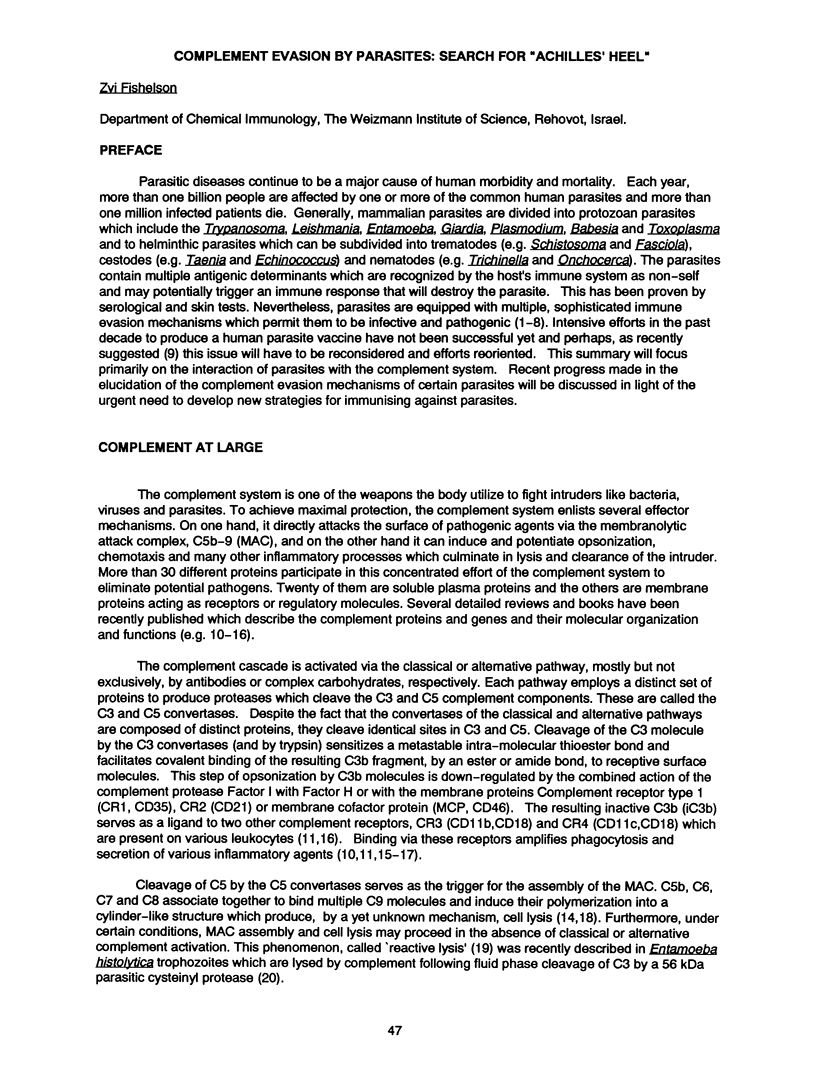
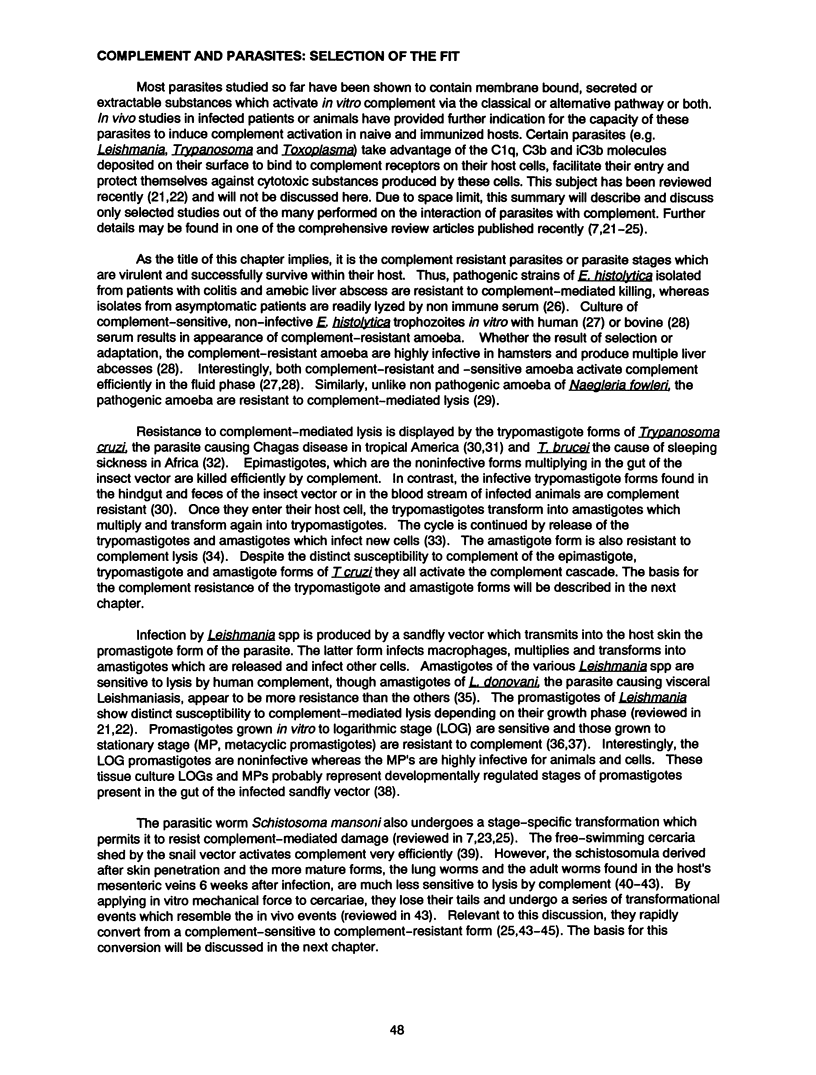
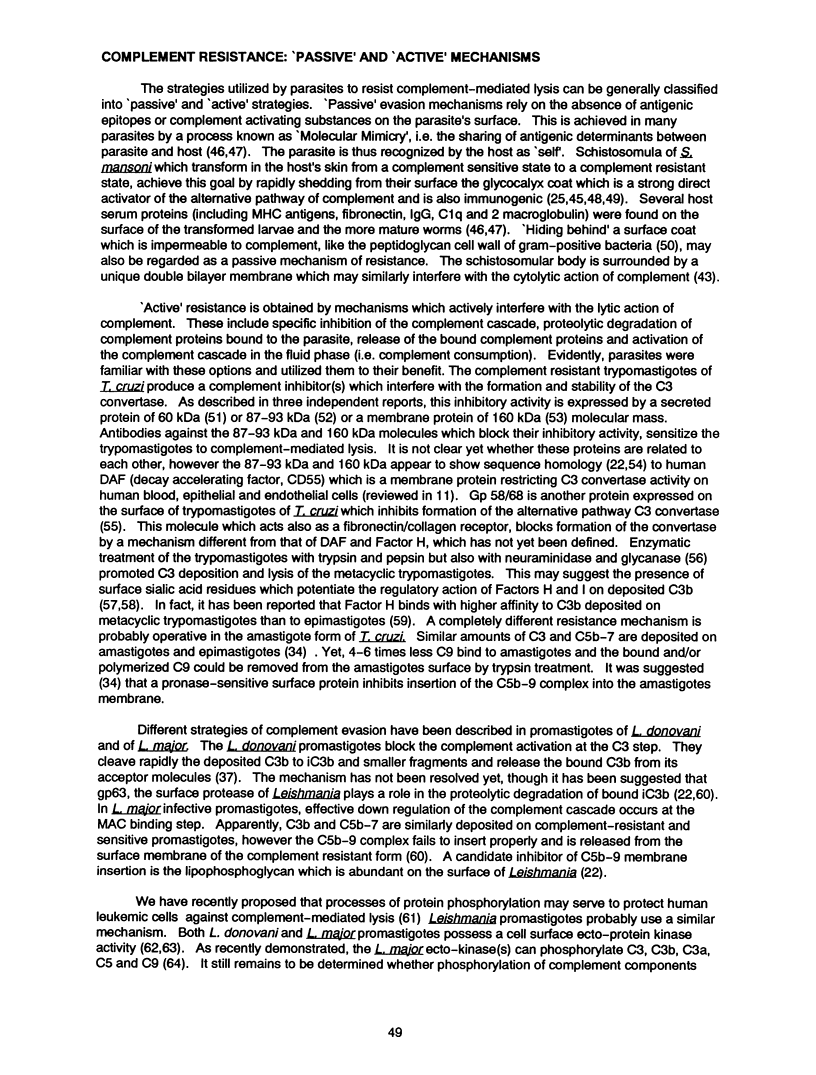
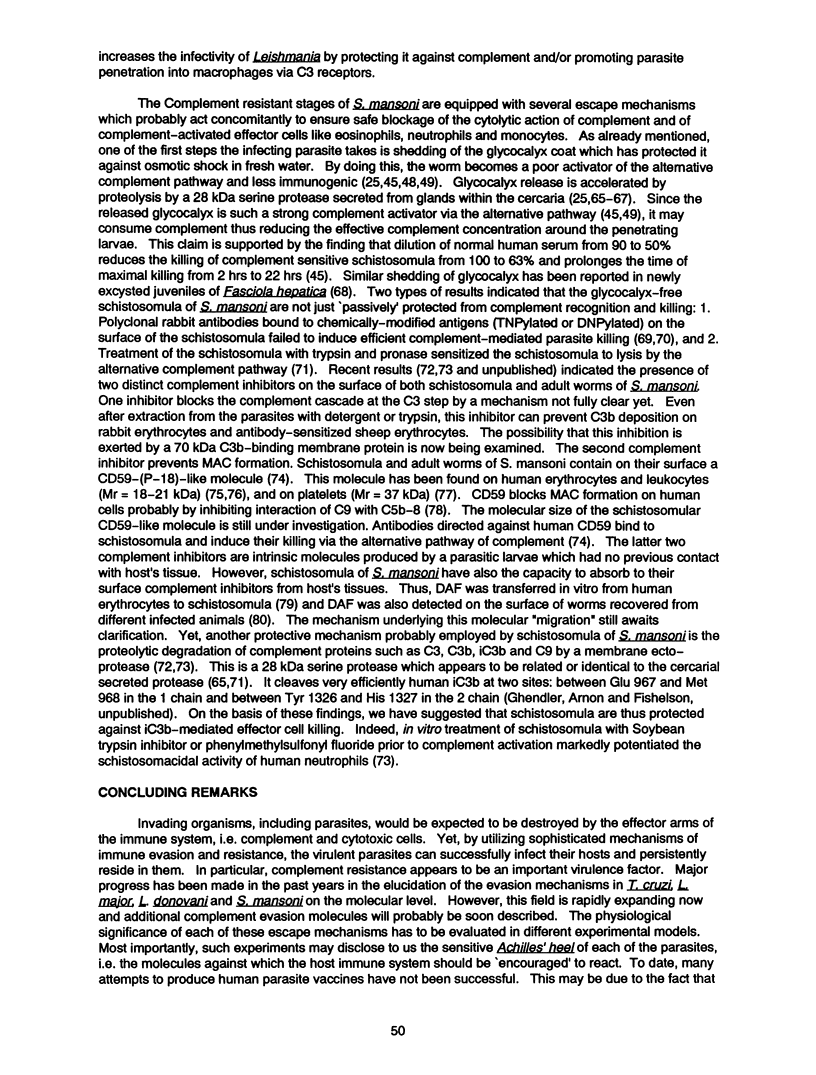
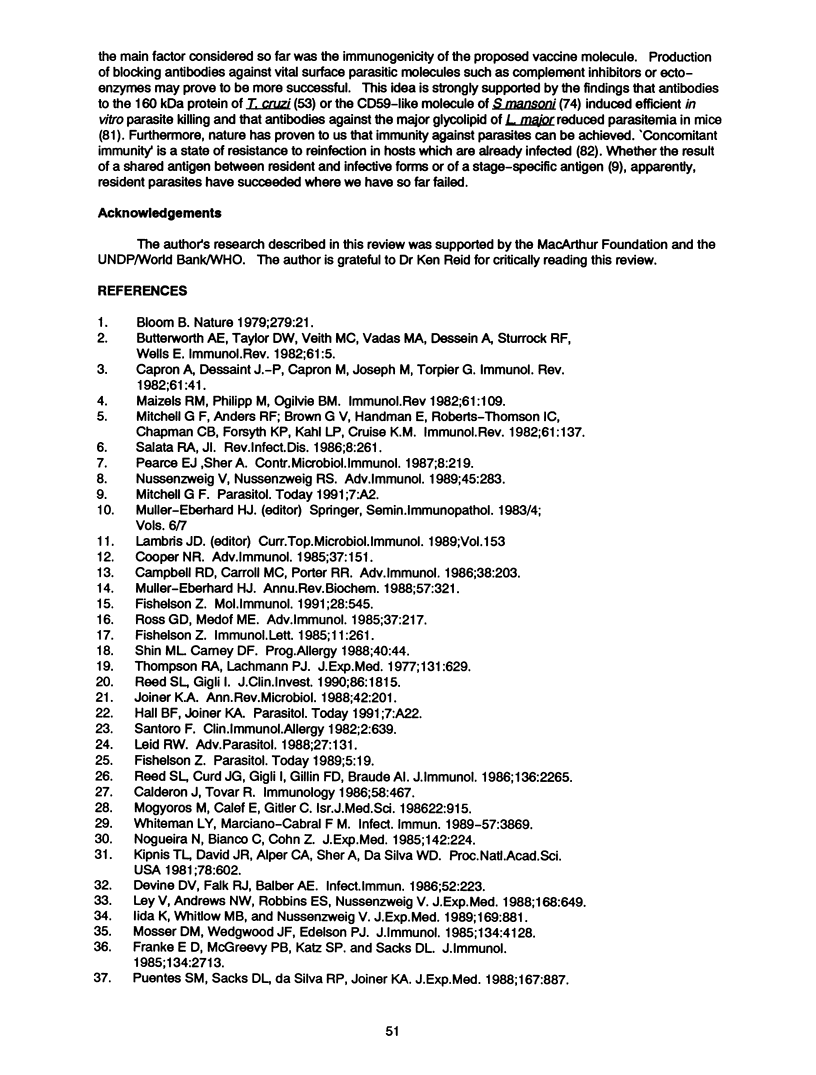
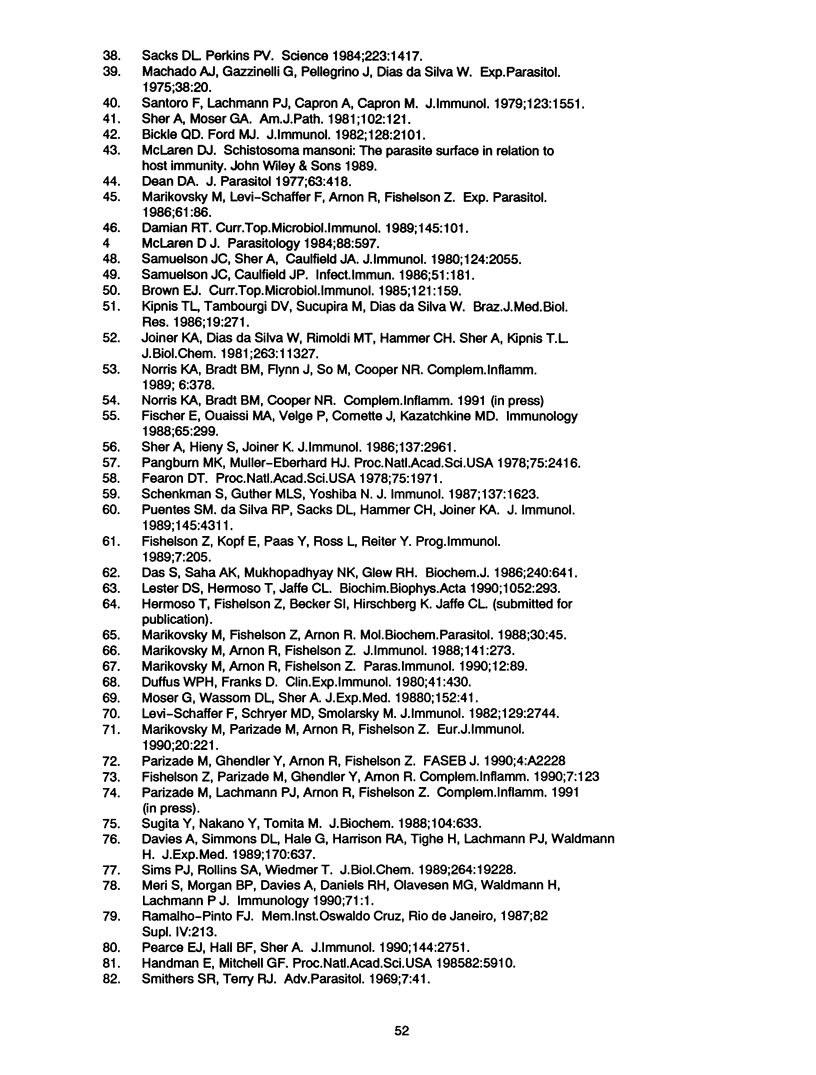
Selected References
These references are in PubMed. This may not be the complete list of references from this article.
- Bickle Q. D., Ford M. J. Studies on the surface antigenicity and susceptibility to antibody-dependent killing of developing schistosomula using sera from chronically infected mice and mice vaccinated with irradiated cercariae. J Immunol. 1982 May;128(5):2101–2106. [PubMed] [Google Scholar]
- Brown E. J. Interaction of gram-positive microorganisms with complement. Curr Top Microbiol Immunol. 1985;121:159–187. doi: 10.1007/978-3-642-45604-6_8. [DOI] [PubMed] [Google Scholar]
- Calderon J., Tovar R. Loss of susceptibility to complement lysis in Entamoeba histolytica HM1 by treatment with human serum. Immunology. 1986 Jul;58(3):467–471. [PMC free article] [PubMed] [Google Scholar]
- Campbell R. D., Carroll M. C., Porter R. R. The molecular genetics of components of complement. Adv Immunol. 1986;38:203–244. doi: 10.1016/s0065-2776(08)60007-3. [DOI] [PubMed] [Google Scholar]
- Cooper N. R. The classical complement pathway: activation and regulation of the first complement component. Adv Immunol. 1985;37:151–216. doi: 10.1016/s0065-2776(08)60340-5. [DOI] [PubMed] [Google Scholar]
- Damian R. T. Molecular mimicry: parasite evasion and host defense. Curr Top Microbiol Immunol. 1989;145:101–115. doi: 10.1007/978-3-642-74594-2_9. [DOI] [PubMed] [Google Scholar]
- Das S., Saha A. K., Mukhopadhyay N. K., Glew R. H. A cyclic nucleotide-independent protein kinase in Leishmania donovani. Biochem J. 1986 Dec 15;240(3):641–649. doi: 10.1042/bj2400641. [DOI] [PMC free article] [PubMed] [Google Scholar]
- Davies A., Simmons D. L., Hale G., Harrison R. A., Tighe H., Lachmann P. J., Waldmann H. CD59, an LY-6-like protein expressed in human lymphoid cells, regulates the action of the complement membrane attack complex on homologous cells. J Exp Med. 1989 Sep 1;170(3):637–654. doi: 10.1084/jem.170.3.637. [DOI] [PMC free article] [PubMed] [Google Scholar]
- Dean D. A. Decreased binding of cytotoxic antibody by developing Schistosoma mansoni. Evidence for a surface change independent of host antigen adsorption and membrane turnover. J Parasitol. 1977 Jun;63(3):418–426. [PubMed] [Google Scholar]
- Devine D. V., Falk R. J., Balber A. E. Restriction of the alternative pathway of human complement by intact Trypanosoma brucei subsp. gambiense. Infect Immun. 1986 Apr;52(1):223–229. doi: 10.1128/iai.52.1.223-229.1986. [DOI] [PMC free article] [PubMed] [Google Scholar]
- Duffus W. P., Franks D. In vitro effect of immune serum and bovine granulocytes on juvenile Fasciola hepatica. Clin Exp Immunol. 1980 Sep;41(3):430–440. [PMC free article] [PubMed] [Google Scholar]
- Fearon D. T. Regulation by membrane sialic acid of beta1H-dependent decay-dissociation of amplification C3 convertase of the alternative complement pathway. Proc Natl Acad Sci U S A. 1978 Apr;75(4):1971–1975. doi: 10.1073/pnas.75.4.1971. [DOI] [PMC free article] [PubMed] [Google Scholar]
- Fischer E., Ouaissi M. A., Velge P., Cornette J., Kazatchkine M. D. gp 58/68, a parasite component that contributes to the escape of the trypomastigote form of T. cruzi from damage by the human alternative complement pathway. Immunology. 1988 Oct;65(2):299–303. [PMC free article] [PubMed] [Google Scholar]
- Fishelson Z. Cell triggering by activated complement components. Immunol Lett. 1985;11(5-6):261–276. doi: 10.1016/0165-2478(85)90107-5. [DOI] [PubMed] [Google Scholar]
- Fishelson Z. Complement C3: a molecular mosaic of binding sites. Mol Immunol. 1991 Apr-May;28(4-5):545–552. doi: 10.1016/0161-5890(91)90169-k. [DOI] [PubMed] [Google Scholar]
- Fishelson Z. Complement and parasitic trematodes. Parasitol Today. 1989 Jan;5(1):19–25. doi: 10.1016/0169-4758(89)90218-4. [DOI] [PubMed] [Google Scholar]
- Franke E. D., McGreevy P. B., Katz S. P., Sacks D. L. Growth cycle-dependent generation of complement-resistant Leishmania promastigotes. J Immunol. 1985 Apr;134(4):2713–2718. [PubMed] [Google Scholar]
- Hall B. F., Joiner K. A. Strategies of obligate intracellular parasites for evading host defences. Immunol Today. 1991 Mar;12(3):A22–A27. doi: 10.1016/S0167-5699(05)80007-6. [DOI] [PubMed] [Google Scholar]
- Iida K., Whitlow M. B., Nussenzweig V. Amastigotes of Trypanosoma cruzi escape destruction by the terminal complement components. J Exp Med. 1989 Mar 1;169(3):881–891. doi: 10.1084/jem.169.3.881. [DOI] [PMC free article] [PubMed] [Google Scholar]
- Joiner K. A. Complement evasion by bacteria and parasites. Annu Rev Microbiol. 1988;42:201–230. doi: 10.1146/annurev.mi.42.100188.001221. [DOI] [PubMed] [Google Scholar]
- Joiner K. A., daSilva W. D., Rimoldi M. T., Hammer C. H., Sher A., Kipnis T. L. Biochemical characterization of a factor produced by trypomastigotes of Trypanosoma cruzi that accelerates the decay of complement C3 convertases. J Biol Chem. 1988 Aug 15;263(23):11327–11335. [PubMed] [Google Scholar]
- Kipnis T. L., David J. R., Alper C. A., Sher A., da Silva W. D. Enzymatic treatment transforms trypomastigotes of Trypanosoma cruzi into activators of alternative complement pathway and potentiates their uptake by macrophages. Proc Natl Acad Sci U S A. 1981 Jan;78(1):602–605. doi: 10.1073/pnas.78.1.602. [DOI] [PMC free article] [PubMed] [Google Scholar]
- Kipnis T. L., Tambourgi D. V., Sucupira M., Dias-da-Silva W. Effect of Trypanosoma cruzi membrane components on the formation of the classical pathway C3 convertase. Braz J Med Biol Res. 1986;19(2):271–278. [PubMed] [Google Scholar]
- Leid R. W. Parasites and complement. Adv Parasitol. 1988;27:131–168. doi: 10.1016/s0065-308x(08)60354-1. [DOI] [PubMed] [Google Scholar]
- Lester D. S., Hermoso T., Jaffe C. L. Extracellular phosphorylation in the parasite, Leishmania major. Biochim Biophys Acta. 1990 May 2;1052(2):293–298. doi: 10.1016/0167-4889(90)90224-2. [DOI] [PubMed] [Google Scholar]
- Ley V., Andrews N. W., Robbins E. S., Nussenzweig V. Amastigotes of Trypanosoma cruzi sustain an infective cycle in mammalian cells. J Exp Med. 1988 Aug 1;168(2):649–659. doi: 10.1084/jem.168.2.649. [DOI] [PMC free article] [PubMed] [Google Scholar]
- Maizels R. M., Philipp M., Ogilvie B. M. Molecules on the surface of parasitic nematodes as probes of the immune response in infection. Immunol Rev. 1982;61:109–136. doi: 10.1111/j.1600-065x.1982.tb00375.x. [DOI] [PubMed] [Google Scholar]
- Marikovsky M., Arnon R., Fishelson Z. Proteases secreted by transforming schistosomula of Schistosoma mansoni promote resistance to killing by complement. J Immunol. 1988 Jul 1;141(1):273–278. [PubMed] [Google Scholar]
- Marikovsky M., Fishelson Z., Arnon R. Purification and characterization of proteases secreted by transforming schistosomula of Schistosoma mansoni. Mol Biochem Parasitol. 1988 Jul;30(1):45–54. doi: 10.1016/0166-6851(88)90131-4. [DOI] [PubMed] [Google Scholar]
- Marikovsky M., Levi-Schaffer F., Arnon R., Fishelson Z. Schistosoma mansoni: killing of transformed schistosomula by the alternative pathway of human complement. Exp Parasitol. 1986 Feb;61(1):86–94. doi: 10.1016/0014-4894(86)90138-4. [DOI] [PubMed] [Google Scholar]
- Marikovsky M., Parizade M., Arnon R., Fishelson Z. Complement regulation on the surface of cultured schistosomula and adult worms of Schistosoma mansoni. Eur J Immunol. 1990 Jan;20(1):221–227. doi: 10.1002/eji.1830200132. [DOI] [PubMed] [Google Scholar]
- McLaren D. J. Disguise as an evasive stratagem of parasitic organisms. Parasitology. 1984 Aug;88(Pt 4):597–611. doi: 10.1017/s0031182000085516. [DOI] [PubMed] [Google Scholar]
- Meri S., Morgan B. P., Davies A., Daniels R. H., Olavesen M. G., Waldmann H., Lachmann P. J. Human protectin (CD59), an 18,000-20,000 MW complement lysis restricting factor, inhibits C5b-8 catalysed insertion of C9 into lipid bilayers. Immunology. 1990 Sep;71(1):1–9. [PMC free article] [PubMed] [Google Scholar]
- Mosser D. M., Wedgwood J. F., Edelson P. J. Leishmania amastigotes: resistance to complement-mediated lysis is not due to a failure to fix C3. J Immunol. 1985 Jun;134(6):4128–4131. [PubMed] [Google Scholar]
- Müller-Eberhard H. J. Molecular organization and function of the complement system. Annu Rev Biochem. 1988;57:321–347. doi: 10.1146/annurev.bi.57.070188.001541. [DOI] [PubMed] [Google Scholar]
- Nogueira N., Bianco C., Cohn Z. Studies on the selective lysis and purification of Trypanosoma cruzi. J Exp Med. 1975 Jul 1;142(1):224–229. doi: 10.1084/jem.142.1.224. [DOI] [PMC free article] [PubMed] [Google Scholar]
- Nussenzweig V., Nussenzweig R. S. Rationale for the development of an engineered sporozoite malaria vaccine. Adv Immunol. 1989;45:283–334. doi: 10.1016/s0065-2776(08)60695-1. [DOI] [PubMed] [Google Scholar]
- Pangburn M. K., Müller-Eberhard H. J. Complement C3 convertase: cell surface restriction of beta1H control and generation of restriction on neuraminidase-treated cells. Proc Natl Acad Sci U S A. 1978 May;75(5):2416–2420. doi: 10.1073/pnas.75.5.2416. [DOI] [PMC free article] [PubMed] [Google Scholar]
- Pearce E. J., Hall B. F., Sher A. Host-specific evasion of the alternative complement pathway by schistosomes correlates with the presence of a phospholipase C-sensitive surface molecule resembling human decay accelerating factor. J Immunol. 1990 Apr 1;144(7):2751–2756. [PubMed] [Google Scholar]
- Pearce E. J., Sher A. Mechanisms of immune evasion in schistosomiasis. Contrib Microbiol Immunol. 1987;8:219–232. [PubMed] [Google Scholar]
- Puentes S. M., Sacks D. L., da Silva R. P., Joiner K. A. Complement binding by two developmental stages of Leishmania major promastigotes varying in expression of a surface lipophosphoglycan. J Exp Med. 1988 Mar 1;167(3):887–902. doi: 10.1084/jem.167.3.887. [DOI] [PMC free article] [PubMed] [Google Scholar]
- Reed S. L., Curd J. G., Gigli I., Gillin F. D., Braude A. I. Activation of complement by pathogenic and nonpathogenic Entamoeba histolytica. J Immunol. 1986 Mar 15;136(6):2265–2270. [PubMed] [Google Scholar]
- Reed S. L., Gigli I. Lysis of complement-sensitive Entamoeba histolytica by activated terminal complement components. Initiation of complement activation by an extracellular neutral cysteine proteinase. J Clin Invest. 1990 Dec;86(6):1815–1822. doi: 10.1172/JCI114911. [DOI] [PMC free article] [PubMed] [Google Scholar]
- Ross G. D., Medof M. E. Membrane complement receptors specific for bound fragments of C3. Adv Immunol. 1985;37:217–267. doi: 10.1016/s0065-2776(08)60341-7. [DOI] [PubMed] [Google Scholar]
- Sacks D. L., Perkins P. V. Identification of an infective stage of Leishmania promastigotes. Science. 1984 Mar 30;223(4643):1417–1419. doi: 10.1126/science.6701528. [DOI] [PubMed] [Google Scholar]
- Salata R. A., Ravdin J. I. Review of the human immune mechanisms directed against Entamoeba histolytica. Rev Infect Dis. 1986 Mar-Apr;8(2):261–272. doi: 10.1093/clinids/8.2.261. [DOI] [PubMed] [Google Scholar]
- Samuelson J. C., Caulfield J. P. Cercarial glycocalyx of Schistosoma mansoni activates human complement. Infect Immun. 1986 Jan;51(1):181–186. doi: 10.1128/iai.51.1.181-186.1986. [DOI] [PMC free article] [PubMed] [Google Scholar]
- Samuelson J. C., Sher A., Caulfield J. P. Newly transformed schistosomula spontaneously lose surface antigens and C3 acceptor sites during culture. J Immunol. 1980 Apr;124(4):2055–2057. [PubMed] [Google Scholar]
- Santoro F., Lachmann P. J., Capron A., Capron M. Activation of complement by Schistosoma mansoni schistosomula: killing of parasites by the alternative pathway and requirement of IgG for classical pathway activation. J Immunol. 1979 Oct;123(4):1551–1557. [PubMed] [Google Scholar]
- Schenkman S., Güther M. L., Yoshida N. Mechanism of resistance to lysis by the alternative complement pathway in Trypanosoma cruzi trypomastigotes: effect of specific monoclonal antibody. J Immunol. 1986 Sep 1;137(5):1623–1628. [PubMed] [Google Scholar]
- Sher A., Hieny S., Joiner K. Evasion of the alternative complement pathway by metacyclic trypomastigotes of Trypanosoma cruzi: dependence on the developmentally regulated synthesis of surface protein and N-linked carbohydrate. J Immunol. 1986 Nov 1;137(9):2961–2967. [PubMed] [Google Scholar]
- Sher A., Moser G. Schistosomiasis: immunologic properties of developing schistosomula. Am J Pathol. 1981 Jan;102(1):121–126. [PMC free article] [PubMed] [Google Scholar]
- Shin M. L., Carney D. F. Cytotoxic action and other metabolic consequences of terminal complement proteins. Prog Allergy. 1988;40:44–81. [PubMed] [Google Scholar]
- Sims P. J., Rollins S. A., Wiedmer T. Regulatory control of complement on blood platelets. Modulation of platelet procoagulant responses by a membrane inhibitor of the C5b-9 complex. J Biol Chem. 1989 Nov 15;264(32):19228–19235. [PubMed] [Google Scholar]
- Sugita Y., Nakano Y., Tomita M. Isolation from human erythrocytes of a new membrane protein which inhibits the formation of complement transmembrane channels. J Biochem. 1988 Oct;104(4):633–637. doi: 10.1093/oxfordjournals.jbchem.a122524. [DOI] [PubMed] [Google Scholar]
- Thompson R. A., Lachmann P. J. Reactive lysis: the complement-mediated lysis of unsensitized cells. I. The characterization of the indicator factor and its identification as C7. J Exp Med. 1970 Apr 1;131(4):629–641. doi: 10.1084/jem.131.4.629. [DOI] [PMC free article] [PubMed] [Google Scholar]
- Whiteman L. Y., Marciano-Cabral F. Resistance of highly pathogenic Naegleria fowleri amoebae to complement-mediated lysis. Infect Immun. 1989 Dec;57(12):3869–3875. doi: 10.1128/iai.57.12.3869-3875.1989. [DOI] [PMC free article] [PubMed] [Google Scholar]


